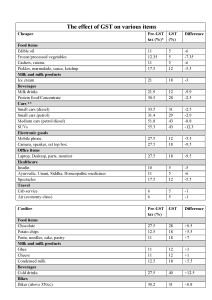Sept.17: COVER STORY
- Posted by CERC India
- Posted in September
How GST will benefit the consumer
* Mobile phones, cars cheaper * Milk drinks, ice cream will cost less * Banking services, insurance, telecom costlier * Rates up for televisions, refrigerators
The Goods and Services Tax (GST) came into effect in India on 1 July 2017 amid much fanfare. GST is touted to be the biggest tax reform since Independence. Many central and state taxes are absorbed in this one tax. In fact, one nation, one market, one tax – is the slogan for GST.What is GST?
GST is a destination based tax levied on the value added at all stages right from manufacture up to final consumption. The credit of tax paid (input tax credit) at the previous stage is available as a set-off at the next stage of transaction.
Who has to pay GST?
All businesses and traders with annual sales of over Rs. 20 lakh have to pay GST. The threshold for paying GST is Rs.10 lakh in the case of northeastern and special category states. GST will be levied by both the Central and state governments.
What are the tax slabs?
Goods and services have been broadly put into four tax slabs: 5%, 12%, 18% and 28%. Some goods and services are exempt. Precious metals like gold will attract a separate tax rate of 3%. A cess will be levied over the peak rate of 28% cent on specified luxury and ‘sin or demerit’ goods. For instance, aerated drinks taxed at 28% will attract an additional cess of 12%. Similarly, a cess has been imposed on filter cigarettes ranging from Rs. 485 to Rs. 792 per 1,000 sticks.
Taxes absorbed by GST
The Central and state taxes absorbed under GST include central excise duty, additional customs duty, service tax, value-added tax (VAT), central sales tax, luxury tax, entertainment tax, taxes on advertisements and taxes on lotteries, betting and gambling.
Products not covered
The products kept out of the ambit of GST for the moment are liquor, petrol, diesel, natural gas and jet fuel. Electricity has also been kept out of GST. The existing taxation system (VAT and Central Excise) will continue in respect of the above commodities.Â
Where to go for help
- askGST_GoI: This is the official twitter handle of the Govt. for queries on GST.
- GST toll free numbers – 1800 103 9271, 1800 1200 232
- Help desk number: 0124-4688999
- Write to us: helpdesk@gst.gov.in;helpdesk@icegate.gov.in
- GST Rate finder App: You can find this in Google Play StoreÂ
Benefits of GST
- Experts say the overall impact of GST on prices will be neutral as tax rates have been cut on mass consumption items and hiked on higher-end products.
- GST will be beneficial as it will reduce the overall tax burden on goods and services currently estimated to be 25-30%.
- To make sure that the reduced tax burden is passed on to consumers in the form of lower prices, the government has introduced an anti-profiteering clause.
- Inter-state transportation of goods will become more efficient.
- GDP growth is likely to be accelerated by 1.5-2%.
- GST will be easy to administer and enforce.
- Uniformity of tax rates across the country will increase ease of doing business.
- Cascading taxes or double taxation will be avoided.
- Improved tax compliance will result in higher government revenues.Â
Myths and facts
Myth: Now it’s one nation one tax.
Reality: Petrol and diesel are still outside GST’s ambit and their tax rates vary significantly across states.
Myth:Â No tax other than GST is now a reality.
Reality:Â GST only subsumes central and state taxes. The levies charged by local bodies are still outside its ambit.
Myth: Prices will shoot up.
Reality: Though the GST rates seem high, it is only because the entire tax is now visible to the consumer. Now, effective tax rates will be lower for most products.
Myth: GST will be charged twice, if you make payments via credit card.
Reality:Â There is no additional GST for credit card payments. But there is GST on convenience charges levied by companies which comes to a small amount.Â
[ Kindly click on table to view full size ]
Table source: dailybhaskar.comÂ
*The pre-GST rates may vary as each state had different tax structure
**Small car (diesel) less than 1500cc. Small car (petrol) less than 1200cc. Medium Cars between 1200cc and 1500cc.Â
Disclaimer: The facts presented in this article (including the table) are as per the situation at the time Grahak Sathi August-September 2017 went to press.Â
Sources:Â Central Board of Excise and Customs (CBEC) website, www.ndtv.com, www.livemint.com, Economic Times, Business Standard
Â







